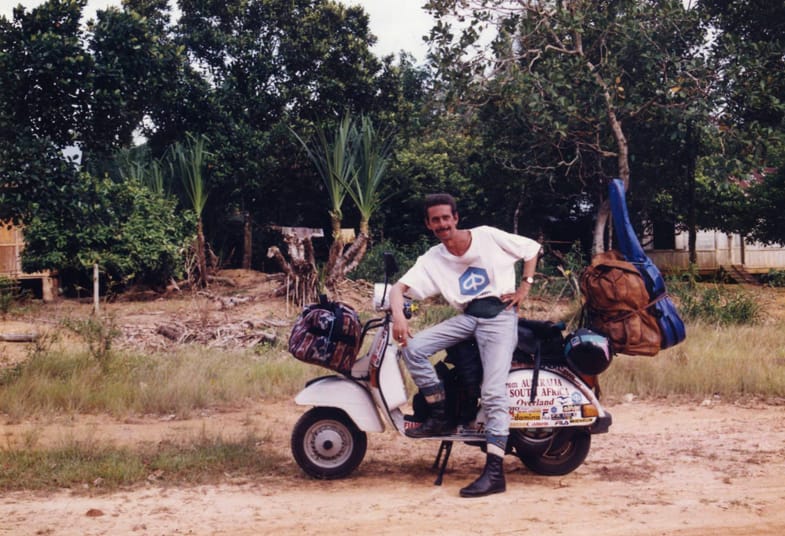


The Vespa has enjoyed an important racing career and is the protagonist of many legendary journeys. In the 1950s, Vespa scooters were successful entrants in countless official motorcycling events throughout Europe (speed and cross-country trials). The Vespa was also the star player of other unusual “adventures”. In 1952 Frenchman Georges Monneret built an “amphibian” Vespa for the Paris-London race, with which he successfully crossed the Channel. 1949 saw the construction of the Vespa 125 Corsa, whose frame was in the aluminium alloy used to build aircraft and assembled with rivets, also in alloy, a technologically advanced solution at the time. The enlarged fuel tank elongated towards the handlebar provided greater capacity for optimised riding at top speed.

The Vespa 125 Corsa took part in many local races and secured a series of important victories. In 1950 Giuseppe Cau and Dino Mazzoncini took first and second place in the Bologna Grand Prix. The same year, Giuseppe Cau also won the Perugia Race, riding Vespa 125 Corsa n. 38.

On 7 April 1950, on the Montlhery race track in France, in a ten-hour event with three riders alternating on the scooter, the Vespa broke 17 world records, including speed (an average of 134 km/h), the 100 miles (average 129.7 km/h), the 500 miles (average 123.9 km/h), the 1,000 km (average 124.3 km/h) and the 10 hours, covering a distance of 1,049 km.


In 1951 Piaggio developed a Vespa 125cc prototype for speed trials, and set the world speed record.

This highly original 125, the “Vespa Siluro”, was ridden at top speed by tester Dino Mazzoncini on the Rome-Ostia motorway, and set a new record with a time of 21 seconds and 4 hundredths at an average speed of 171.1 km/h. An excellent result, especially considering that a motorway has a much more uneven surface than a race track.

The engine was designed by Corradino d’Ascanio, who described it as follows: “I also designed a racing scooter with a 125cc two-stroke water-cooled boxer engine; with this engine, which delivered 17 HP at 10,000 revs, our test rider Mazzoncini set the record in the 170 km/h category.” (Corradino d’Ascanio, Appunti sulla mia attività tecnica dal 1928, Piaggio Archives). It was 1951. That same year, the Vespa achieved enormous success in the Varese “Sei Giorni Internazionale”, winning 9 gold medals, more than any other Italian two-wheeler.


1951 also witnessed the first in a countless series of Vespa rallies: an expedition to Congo, an incredible trip with a scooter designed essentially for city traffic. Italian university student Giancarlo Tironi rode to the Arctic Circle on a Vespa. Argentinian Carlos Velez crossed the Andes from Buenos Aires to Santiago. Year after year, the Vespa’s popularity grew among travel-adventure lovers: Italian journalist Roberto Patrignani rode a Vespa from Milan to Tokyo (1964).
Soren Nielsen went to Greenland; James P. Owen rode from the USA to Tierra del Fuego; Santiago Guillen and Antonio Veciana travelled from Madrid to Athens in 1962 (their Vespa, which was decorated personally for the occasion by Salvador Dalì, can still be seen in the Piaggio Museum).

Wally Bergen completed a grand tour of the Antilles; Italians Valenti and Rivadulla rode around Spain; Miss Warral made a round trip from London to Australia; Australian Geoff Dean completed a round-the-world trip on his Vespa. Pierre Delliere, a sergeant in the French air force, reached Saigon in 51 days from Paris, travelling via Afghanistan. From Switzerland, Giuseppe Morandi rode 6,000 km, most of it in the African desert, on a Vespa he had bought in 1948. Ennio Carrega undertook a trip from Genoa to Lapland and back in just 12 days. Two Danish journalists, brother and sister Erik and Elizabeth Thrane, went to Bombay on a Vespa. And it is impossible to keep count of the Vespa riders from all over Europe and the world who have made the “legendary” journey to the North Cape.
In 1980, two Vespa PX 200E scooters reached the finishing line of the Paris-Dakar (the second edition of the classic desert race), ridden by M. Simonot and B. Tcherniawsky. The French team, organised by Jean-François Piot, was assisted by four-times 24-Hour Le Mans winner Henri Pescarolo. The Vespa continued to travel: In July 1992, writer and journalist Giorgio Bettinelli set off from Rome on a Vespa and reached Saigon in March 1993. In 1994-95, again on a Vespa, he covered the 36,000 km from Alaska to Tierra del Fuego. In 1995-96, starting from Melbourne in Australia, Bettinelli travelled to Cape Town, riding more than 52,000 km in twelve months. In 1997, he completed a trip from Chile to Tasmania, via the Americas, Siberia, Europe, Africa, Asia and Oceania, riding 144,000 km in three years and eight months and passing through 90 countries. All told, he clocked up 250,000 kilometres.

And for decades, thousands of riders from every corner of the globe have been jumping on their Vespa scooters, compelled by an irresistible urge to go… and see what lies beyond the horizon.

(Photo courtesy: Giorgio Serafino, Giuliana Foresi, Namibia).